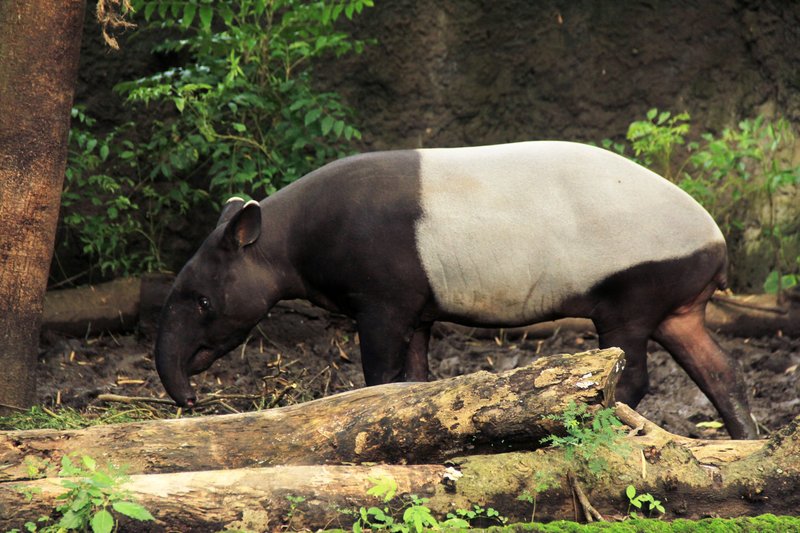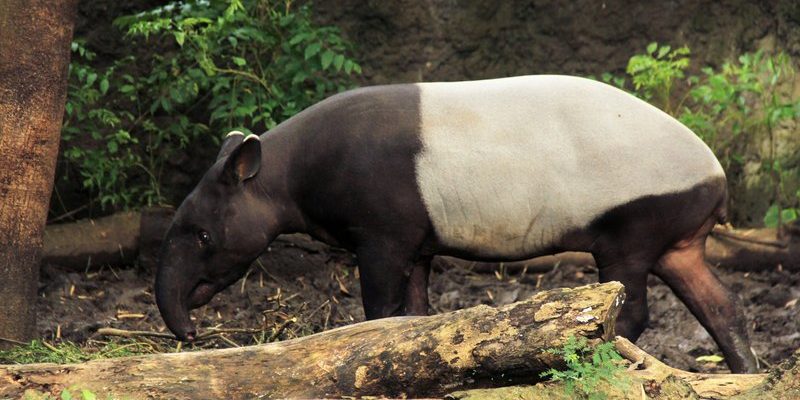
The Malayan tapir is a unique animal, part of a family that includes some other intriguing species. Learning about them can be like uncovering a hidden treasure trove of nature’s secrets. You might be wondering how to tell these animals apart or what similarities they share. Let’s dive deep into this world and discover ten animals that are similar to the Malayan tapir, exploring their distinct features and behaviors along the way.
1. Other Species of Tapir
The tapir family is small but interesting. There are four other species besides the Malayan tapir: the Brazilian, Baird’s, Mountain, and the Central American tapir. Each of these species shares some characteristics but also has unique traits.
Brazilian tapir, also known as the South American tapir, is the most common type. They have a similar body shape to the Malayan tapir but are generally brown, lacking the stark black-and-white pattern. Their larger size and long, flexible snouts make them quite unique.
Then there’s Baird’s tapir, primarily found in Central America. Not only do they have a similar body structure, but their skin also tends to be a darker brown. You might notice that they are a bit more slender than their Malayan cousin.
Identifying Tapirs
When distinguishing between these species, look at their colors, sizes, and snout shapes. The Malayan tapir stands out due to its striking color contrast and larger size compared to Brazilian tapirs.
2. Rhinoceros
Rhinoceroses, or rhinos, might seem like an odd comparison, but they share some similarities with tapirs. Both animals have a stout body and a thick, protective skin. They also inhabit similar environments, often found in forests or grasslands.
The main difference? Rhinos are much larger and have their iconic horns. The white rhino and the black rhino from Africa are the most recognized species. While rhinos can weigh over a ton, Malayan tapirs are much smaller, usually weighing between 500 to 700 pounds.
How to Differentiate
To tell a rhino apart from a tapir, focus on size and horn presence. However, both animals have a similar herbivorous diet and share the same gentle demeanor.
3. Hippopotamus
Hippos are another interesting animal to compare with the Malayan tapir. They, too, have a bulky body, short legs, and a big mouth. But here’s where things get interesting: while hippos spend time in the water, tapirs prefer to stay on land, especially in dense forests.
Both animals have a similar body shape and are primarily herbivorous. A hippo can weigh between 3,000 to 4,000 pounds, making it a giant in the animal kingdom.
Spotting the Differences
The easiest way to tell them apart is by their habitats and social behaviors. Hippos are more social and often seen in groups, while tapirs are solitary creatures.
4. Pigs
If you’re looking for another animal that resembles the Malayan tapir, pigs are a great pick! They both share a similar body shape, stoutness, and a love for rooting around on the ground.
However, pigs are generally smaller than tapirs and come in various breeds, with their own colors and patterns. Most notably, domestic pigs have a more versatile diet that can include anything from grains to vegetables.
Understanding Their Habitat
While pigs are often domesticated and found on farms, tapirs roam free in their natural habitats. This key difference in lifestyle sets them apart, even though they share some physical traits.
5. Okapi
Okapis are perhaps one of the most striking animals that are closely related to giraffes, but they also share some similarities with tapirs. With their unique striped back legs, they resemble a mix of a horse and a zebra. The okapi’s body shape is also stout and robust, much like the tapir.
While both animals live in forested areas, the okapi is primarily a browser, feeding on leaves and buds, while tapirs often munch on fruit and vegetation.
Identifying Okapis
To tell an okapi from a tapir, take note of the okapi’s long neck and distinctive markings. The Malayan tapir doesn’t have any of those stripes, making visual identification much easier.
6. Antelope
Certain species of antelope, like the waterbuck or the nyala, share a somewhat similar body shape to the Malayan tapir, especially when considering their stout frames and large bodies.
Antelopes are generally more graceful and are often seen in herds, contrasting the solitary lifestyle of tapirs. The similarities lie mainly in the general body composition and herbivorous diet.
Spotting Differences
The main way to differentiate them is by their horns and gracefulness. Antelopes have long, slender legs and horns that tapirs simply do not possess.
7. Warthog
Warthogs are another fascinating comparison. They have stout bodies with prominent tusks and a bit of a scruffy appearance. While they are different in many aspects, you’ll notice some similarities in body shape and size.
Warthogs are social animals and often seen lounging together, whereas tapirs are solitary. They enjoy similar habitats, usually grassy areas or forests.
Identifying Warthogs
Warthogs are much smaller and have a distinct facial structure, including the tusks that stand out prominently. The smooth skin of a tapir also contrasts with the coarse fur of a warthog.
8. Elephant
Elephants, particularly the Asian elephant, share some similarities with tapirs in terms of body shape and size. Both have stout bodies and are herbivorous. However, elephants are significantly larger and have trunks, which makes them unmistakable.
While elephants roam in herds, tapirs prefer a more solitary lifestyle. Their habitats can overlap in forested areas, though elephants tend to favor more open landscapes.
Finding the Differences
While both animals share a herbivorous diet, the size and presence of a trunk make elephants easy to identify.
9. Capybara
Capybaras might surprise you as a family member of the Malayan tapir due to their similarities in body shape. As the largest rodent in the world, capybaras have a stout body and can often be found near bodies of water.
Despite being semi-aquatic, tapirs are more adapted for forest life. Both love to munch on grass, fruits, and veggies, but capybaras take on a more social lifestyle, often seen in groups.
Distinguishing Capybaras
The easiest way to tell them apart is by size: capybaras are much smaller than tapirs and lack the distinctive coloration of the Malayan tapir.
10. Aardvark
Lastly, let’s take a look at the aardvark. These creatures share a unique body shape, complete with a long snout and a stout body. Though they differ in coloring, both are nocturnal and have a similar diet, feeding on insects, especially ants and termites.
While aardvarks tend to have a more traditional mammalian look, their size and stoutness somewhat mirror the Malayan tapir. One key difference is their long ears and claws, primarily for digging.
Identifying Aardvarks
Aardvarks are nocturnal and have a very different feeding method compared to tapirs. Their long ears and pointy snouts make them easy to tell apart.
In closing, exploring these animals similar to the Malayan tapir reveals a fascinating variety of creatures in the animal kingdom. Each one has unique traits and behaviors that make them special. The next time you spot a tapir or one of its relatives, you’ll have a deeper understanding of their world—and perhaps a greater appreciation for the diversity of life around us.

